What is National Day?
Most countries in the world have them. It is a day in the year that people celebrate an important event in the history of their country or in the formation of a nation. On that day, they either remember a day of independence, or the setting up of a republic, of a saint or a famous ruler etc. It is usually a public holiday and often in any country, there is more than one national day.
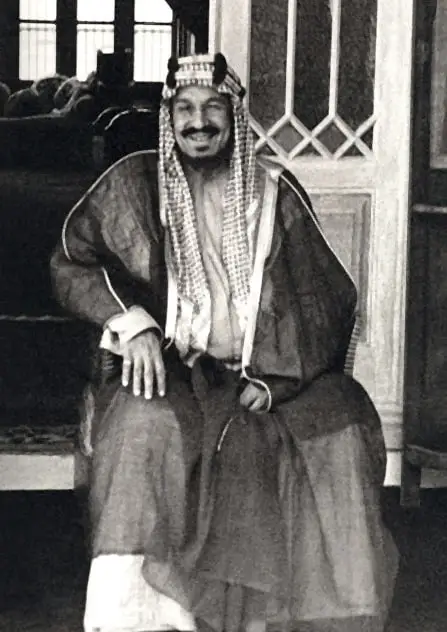
What is National Day for Saudi Arabia?
Since 2005, Saudi National Day has been celebrated on the 23rd of September. It is called ‘Yawm Al Watani’ اليوم الوطني and it commemorates the day in 1932 when King Abdul Aziz Al Saud in a royal decree renamed the former ‘Kingdom of Nejd and Hejaz’ to The Kingdom of Saudi Arabia, العربية السعوديةالسعودية للمملكة
Why do Saudi People Celebrate National Day?
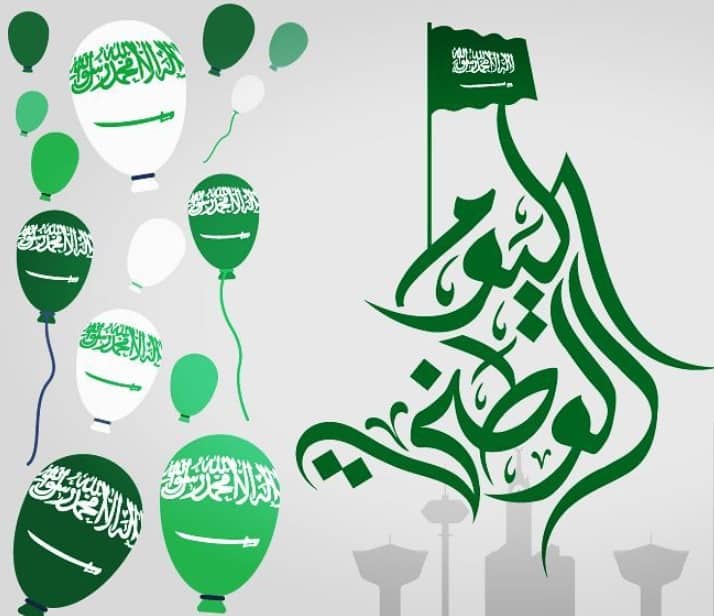
On that day, the beginnings of modern Saudi Arabia in 1932 is remembered. People remember the glorious stories and values that formed the early nation-state. They recall, share and cherish them. (Retold below)
In this remembrance, it is a chance for citizens to renew their allegiance to the beloved homeland and reiterate loyalty to the Saudi King.
On this day, the Saudis are also asked to consider the roles and responsibilities they share in the integration of systems in the modern Saudi state. People ponder such values, express thanks and gratefulness towards their country and to their leaders who for decades have placed the interests of each and every Saudi citizen at the centre of all the advancement and development plans.
Saudi National Day is also a way to inspire a huge national effort towards the continued future development of the nation. (Vision 2030) Saudis working in the public, private or non-profit organisations are asked to work tirelessly to help achieve the hopes and fulfil the aspirations and responsibilities of the country, of their society and the Saudi family.
How do Saudis celebrate Saudi National Day?
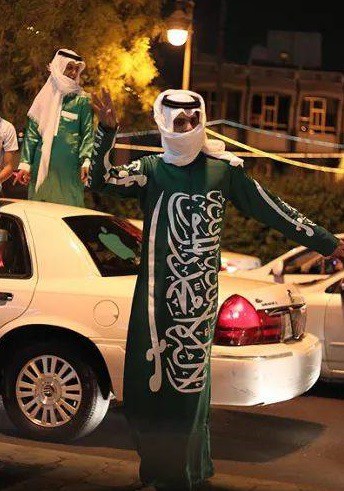
Saudi National Day Celebrations take many forms and are increasing in number year by year. On this day, citizens like to take to the streets in large numbers, to public areas, parks, Malls, shopping centres, beach fronts, promenades and outdoor arenas.
There are many events provided for their entertainment.
These include:
- Public Celebrations and Fun Programs for Kids
- Heritage and Cultural Displays
- Historical Photographic and Artistic Exhibitions
- Films and Educational Exhibitions
- Night-Time Laser and Firework Displays
- Aircraft Displays and Fly-Bys
- Theatrical Plays
- Tours of Heritage
- Sites Late Shopping and Discounts
- School Exhibitions and Activities
The Fascinating Story of Saudi Unification

The story of the unification of Saudi Arabia is an interesting one. It took place during three decades, between 1902 and 1932. In that period, King Bin Abdul Aziz Al Saud recaptured and unified the unforgiving lands of the Saudi peninsula. In January 1932, in a royal decree, he proclaimed that Saudi Arabia was now unified and it became known as the Third Saudi State.
Muhammed Ibn Abdal Wahab and Ibn Saud
First Saudi State 1700-1800

However, in reality, the story of the unification of Saudi Arabia began almost two hundred years before 1932, in the small town of Diryah, located near Riyadh in central Saudi Arabia. The Diriyah then was the emirate capital and the original home of the Saudi Royal family and the centre of the First Saudi family dynasty 1744-1818.
Historically, the Saud family dynasty began with an agreement between the religious reformer Mohammed ibn Abdul Wahab and the Emir of Diriyah Mohammed Ibn Saud. (known as Ibn Saud).

Tawheed or Testimony of Faith in Islam
The agreement between the two was to bring the wayward Arabs of the time back to the true, original principles of Islam. It was, of course, the belief in Tawheed or the oneness, the unity and uniqueness of the one true Allah (God).
Mohammed ibn Abdul Wahab’s ideology rejected misinformed beliefs that sought to associate others with Allah (God) (shirk) or those that called on anything/anyone to intercede with Allah (God). It also rejected outdated Islamic laws.
Adbul Wahab and his followers worked hard to call the errant Arabs back to practising Islam in the way it had been understood and practised by the early Muslims.
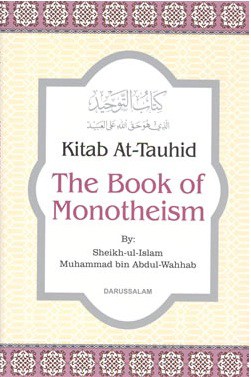
The call was based on Muhamad Ibn Abdal Wahab’s book, ‘The Book of Tawheed’, Kitab Al Taheed. This book was based on the Quranic teachings and the saying (hadith) of Prophet Mohammed (SAW).
In it, he urged Muslims to return to the fundamental practices of Islam that had been forgotten or ignored such as the 5 daily prayers, (salat) fasting (sawm), making supplication (dua), seeking refuge (istidha) and help (istana) and forgiveness (istighatha) from Allah (SWT). Arabs at that time had strayed so far from them.
Today, this movement in Saudi Arabia is unflatteringly termed, Wahabism. Many scholars and observers though prefer to call it Salafism which also describes other purist types of Islamic thought.
During the 66 years following the pact, the Najd based First Saudi State spread out and in time managed to conquer all of Saudi Arabia ending in the conquest of Ottoman-controlled Mecca and the region in 1802.

Mohammed Ali Pasha and his Son, Ibrahim
1811- 1818 Ottoman-Wahhabi War
The Arab conquest of Mecca in 1805 was seen as an insult to the long-standing Turkish, Ottoman Empire that had been controlling the region for the past 300 hundred years. To get revenge, the Ottoman authorities under Mahmood II, the Turkish/Ottoman Caliph in Constantinople enlisted the help of the Egyptian Ottoman viceroy, Mohammad Ali Pasha.
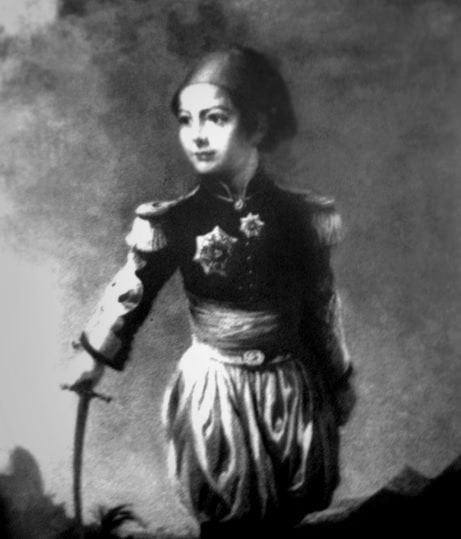
The viceroy sent his son Tusun on a military expedition to the Hejaz to recapture it in 1811. It was initially repelled. However, In 1812, thousands of Egyptian troops were sent to the Arabian peninsula, to the Hijaz and Mecca in order to recapture it for Mahmood II.

At the same time in 1916, Mohammed Ali Pasha’s son, Ibrahim led an Egyptian force to the central region of Najd. As they advanced, the armies captured town after town and finally laid siege its capital, Diriyah.
After a few months holding out, Diriyah fell during the winter of 1818. Followers of Muhammed Ibn Abdul Wahab and the then Al Saud Emir, Abdullah Bin Saud were captured and sent to Egypt and to the Turkish/Ottoman capital, Constantinople.

The Emir Abdullah Bin Saud and his armies had been totally destroyed in the invasion. Abdullah Bin Saud and two companions were sent to Constantinople in Turkey and imprisoned there by the orders of Mahmud II.

At the prison, they were forced to listen to music which they hated and finally beheaded in public for murderous crimes they were accused of committing previously in Mecca, Madinah and Karbala. In an act of final revenge, his severed head was tossed into the Bosphorus river.
The Emirate of Najd
The Second Saudi State 1824-1891
The period of 70 years of the Second Saudi State was a messy affair. The Saud family successfully ousted the occupying Egyptian armies from Diryah in 1824. However, because of ongoing bickering and infighting between the Imam Mohammed Bin Saud’s grandsons and cousins, the Egyptian armies were able to take back control of Diriyah in 1838.
The Egyptians then installed Abdullah Bin Saud’s brother, Khalid, as the Emir of Najd. He was very loyal to them. Over time, the Egyptians lost power in their own land and eventually withdrew from Najd abandoning Khalid in Diriyah.
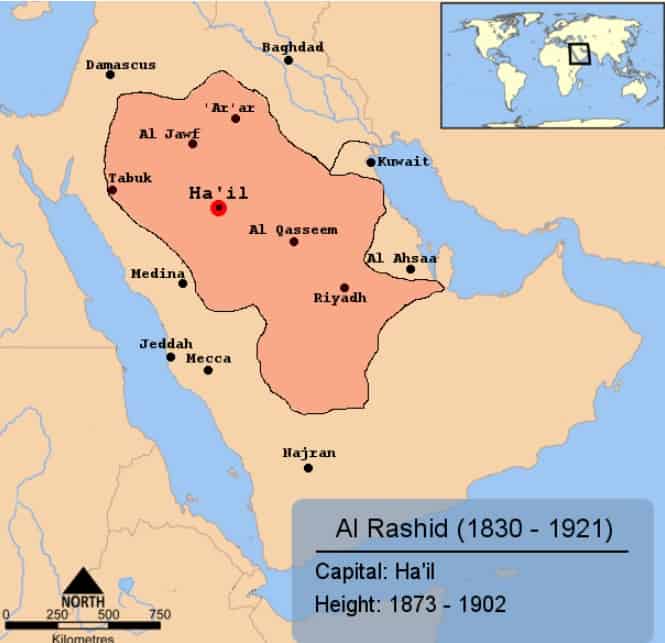
With the support of the Abdullah bin Thumayan and the Rashid ruler in the northern area of Hail, Khalid was ousted. More family infighting and civil war laid the ground for the intervention of Muhammed ibn Abdullah ibn Rashid of Hail who expelled the last Saudi leader Abdul Rahman Ibn Faisal from Najd after the Battle of Mulayda (City of Qassim) in 1891.
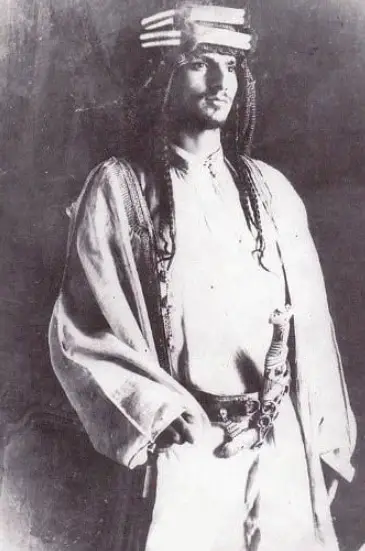
This major battle ended the House of Saud sending Abdul Rahman into exile. He was the father of the subsequent King Abdul Aziz.
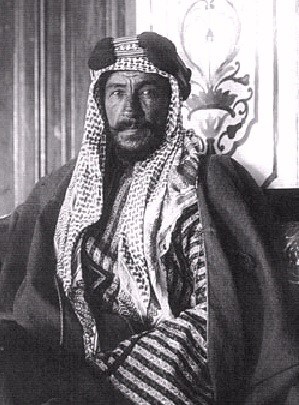
In exile, Abdul Rahman and his family took refuge amongst the Al-Marri Bedouins in the empty quarter (Rub al Khali) in 1893. After 7 months, they travelled to Bahrain at the invitation of the Al Khalifa Royal family. Later, they stayed under the protection of the Al Sabah Royal family in Kuwait. The young Abdul Azizi saw the British in Kuwait. It was a protectorate state at the time. During his time in the protectorate, he learned much about the international power politics of the time.
The wishes of deposed Amir Abdul Rahman and his son Abdul Azizi for the future were clear :
1. To spread the Wahabist Islam
2. To regain control of Diriyah and reestablish the Saudi royal family there.
The young Abdul Aziz was only 16. However, it was he who later took back Diriyah in 1902 and began the process of eventual unification of the Saudi kingdom. The ousted emir, Abdul Rahman died in Riyadh in 1928.
Amir Abdul Azizi Takes Back Riyadh
The Story- 1902
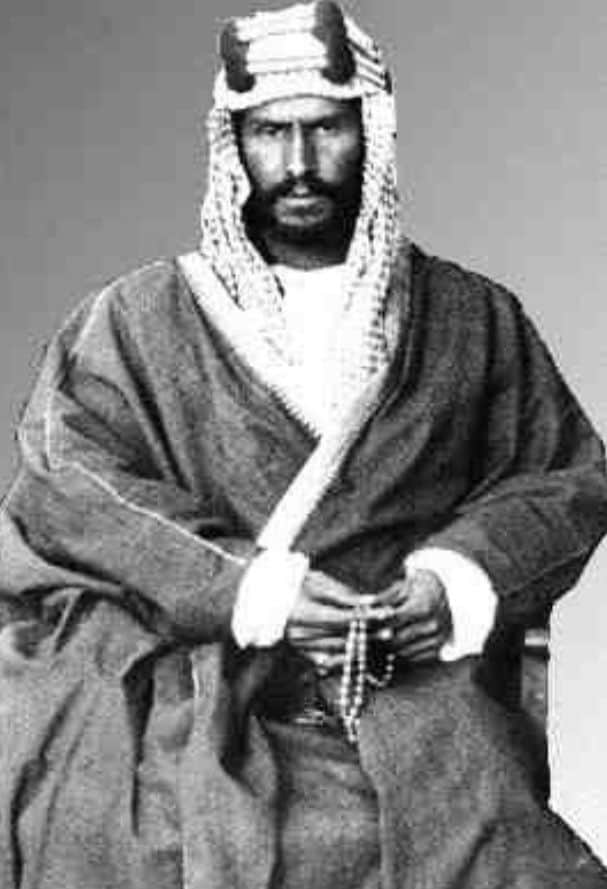
So it was in 1901, that Abdul Aziz and only 60 loyal men rode out across the desert. They were led by Abdul Aziz Bin Abdul Rahman Al Saud. Their goal was to retake Riyadh and to eventually unify the Arabian peninsula. Abdul Aziz was then only 26 years old.
Returning from exile, they sought to attack the headquarters of the Rashidi governor Ajlan based in the Mazmak Fort at the centre of Riyadh.
The Ottoman governor Ajlan used to sleep there each night for protection. That night, Abdul Azizi and a few followers crept into a house located next to the fort. His followers remained outside.
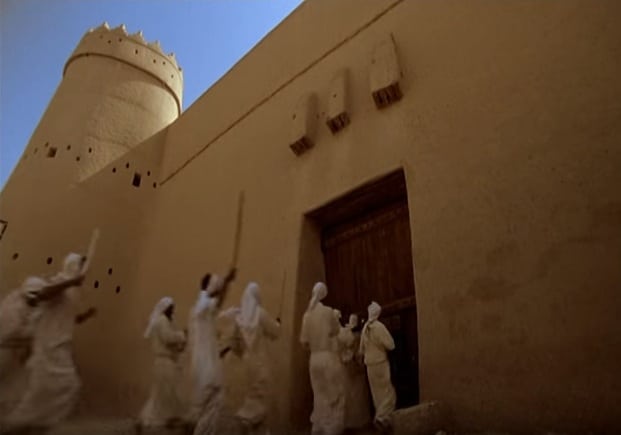
This was to be the second time they had tried to recapture the Mazmat Fort. Six months before they had besieged it for four long months.
Abdul Aziz and his men waited for the morning light knowing that Ajlan would depart the safety of the fort to head home in the morning.
As Ajlan and his men were mounting their horses to leave, Abdul Azizi and his men attacked them with swords and guns. Ajlan and his men got scared and ran back inside the fort.

40 of Abdul Aziz’s men attacked and took over the fort. They killed 80 of Ajlan’s men, including the Governor himself before recapturing the fort entirely and taking back control of Riyadh.
This was in January 1902 and the Saud family had returned once again. The population of Riyadh were delighted and welcomed him.
As they declared victory from the roof of the Mazamak fort, the people said, ‘We hear and we obey ’.
Tired of being ruled by Bin Rashid as their governor, the people were happy to see Ajan gone. Diriyah had been the heart of the Saudi royal family for more than 200 years before and it had also been the capital of the First Saudi State.
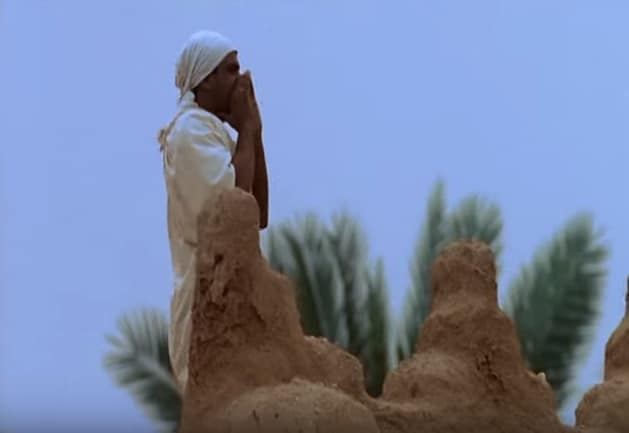
The victory of Abdul Aziz at the Mazamat Fort meant the return of a family dynasty that had formerly controlled the region for centuries. It was also one that was warmly welcomed into the hearts and homes of the Riyad population.
Influence of Mohammed Ibn Abdul Wahab
But it also meant a return to the practice of a reformist brand of Islam as propagated by the 17th century Islamic Mohammed Ibn Abdul Wahab. This combination of royal dynasty and religion was soon to revolutionize the Arabia peninsula.
The Wahabi Islamic movement was founded on absolute adherence to the tenets of the Holy Quran together with the words and teachings of the Prophet Mohammed (SAW). For generations, people used to call the Al Saud rulers by the title of Imam or leader.
Mohamed Abdul Wahab’s reform movement was not a call to something new, rather it was an exhortation to return to the purest way of religion as practised by early generations of Muslims in Arabia.
The religious reform was a response to the debasement of Islamic practice by the Arabs of the time. Not only had they abandoned basic religious formalities, but they also confused Arabic customs with true religious beliefs and had added beliefs that were completely unrelated to correct Islam.
The irrelevant customs and customs and practices became abolished in the light of the true teachings of Mohammed Abul Wahab.
The foundation of Emirate of Diriyah was the teachings of Mohammed Ibn Al Wahab. The principal aim was to purify the religious faith of Muslims and unify the disparate people living on the land. This reformist brand of Islam later came to Iraq, to Syria and eventually to all the Arabic speaking countries.
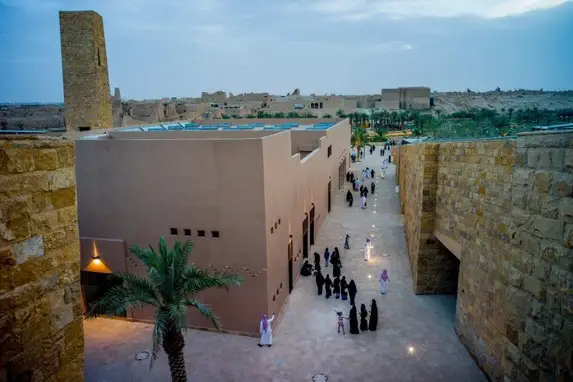
Now, Visitors, Shops, Museums and Restaurants
But of course, by 1891, everything fell apart. The Ibn Saud family had divided and fought each other. The great Imam, Abdul Rahman was exiled with his family and once gain Saudi Arabia fell back again under Turkish control. The Second Saudi State laid in ruins.
Saudi Arabia Under Continuous Ottoman Control
Much of the country was now being controlled by the Ottoman Empire based in the capital Constantinople- the modern-day Istanbul. Islam and Arabia were for centuries united under the banner of the Caliphs of Turkey. They considered themselves as protectors of the faithful across the Muslim world and as such demanded loyalty and subjugation of territories in the Arabian peninsula and beyond.
The British Empire also exerted great influence in the Gulf and with France and Germany were determined to end Ottoman political and economic control. King Abdul Aziz knew the British in Kuwait and later sided with British forces both militarily and financially in his advance across Saudi Arabia in an effort to win back its territories.
After 1902, the excited people of Riyadh and the small towns in the area knew that an Al Saud had returned. They were happy because he seemed to be strong and a lover of powerful Islamic principles and committed to the application of the Islamic (sharia) law.
The Al Saud family represented noble manners and great Islamic values. In Abdul Aziz’s dreams and intentions, they saw an expression of their own hopes, wishes and expectations in relation to future developments.
The people easily fell in line with King Abdul Aziz, and gladly followed him. They too were religious people and in King Abdul Aziz they saw a leader (Imam) who would fulfil their deepest religious aspirations.
Amir Abdul Aziz reaches out to other Tribal Leaders
Once settled into Diriyah, King Abdul Aziz and his family began reaching out to other Amirs and tribes, people who were rulers of their oases. Very quickly, and one by one they began to support the new Amir.
By 1903, Abdul Aziz and his men started to move northwest to Al Qassim to the same region in which his father had been defeated in 1891.
They took on the troops loyal to Al Rashid at Bukadiyah who were heavily supported by the Turkish infantries and armaments. Fierce battles ensued. At Chinaan and filled with faith the Abdul Aziz’s men were outnumbered but overtook and chased Bin Rashid’s men out of the region. The Turks fled to the north.
Abdul Aziz was now in control of Al Qassim. He added it to his growing list of lands. The Ottoman Turks sat and negotiated terms with the Amir and later completely withdrew garrisons from Al Qassim.
Menace of the Bedouin Raiders
Also, during those years, the towns and villages in Arabia were plagued with nomadic Bedouin tribes fighting amongst themselves and harassing and robbing the townspeople.
Tribal raids were met with counter raids, blood feuds and retributions. The result was fear and instability. Abdul Aziz could not fight the tribes nor subject them by using force. He wanted peace and some security. To achieve this he used the power of Islam.
The Amir sent Islamic preachers to the tribes to teach them about Islam and to urged them to settle down in one place into more permanent dwellings, called ‘ijar’. Instead of fighting, the new communities built up around wells and religious centres, mosques where farming and agriculture was developed.
Abdul Aziz’s message to the Bedouin tribes was a call to Tawheed (Unity of God) and to the message of Prophet Mohammed, Allah’s Messenger (SAW). The Amir provided the books of Mohammed Bin Abul Wahab to the Bedouins. He urged them to be better citizens, gave them provisions and arms to protect themselves against those who would fight them for religious causes.
He exhorted them to unite around the Islamic faith and to deny the power of Satan in fighting against each other. The effort was successful and the purist movement persuaded the tribes to return to Islamic faith which they did with love and great religious zeal. The united tribes were called Al Ikhwan or brotherhood. The change in the Bedouin hearts was dramatic and brought about many improvements. More than 200 bedouin settlements resulted.
Abdul Aziz now had the central regions under his power and the support of its people. He was able to provide security and the firm basis on which to live out a peaceful and religious lifestyle. Leaders in the Al Hasa region in the East recognised his value and wanted a part of it.
The Reconquest of Al Hasa under Amir Abdul Aziz
Al Hasa was and still remains today an area rich in agriculture with dates and springs that in previous generations had been controlled by the Saud family. Now, it was under Ottman Turkish control. Life in Al Hasa was also affected by the robbing and violence of the tribes surrounding the urban centres and the oases.
Bedouins thieves were robbing local people in cahoots with Turkish authorities. After raids, the Bedouins divided their spoils and gains with the Turkish officials. To stop this, Abdul Aziz was asked to intervene.
Hesitant at first, there was a possibility that the British might invade, oust the Turks and take control of the Al Hasa lands. Abdul Aziz knew this So, one day he tricked and headed off the marauding tribes before setting off with 900 men to Al Hasa.
Sending some of them ahead to climb into the town, they prepared for his entrance by making a hole in the town wall of Hofuf to later allow him to enter through it to get into the town.
A special hole was prepared for Abdul Azizi in the Al Qut wall with ladders placed at the trench bottom. Later, Abdul Azizi with his men climbed up the ladders and entered the town through the hole.
The townspeople of Al Hasa met him with great joy and relief. They offered him their allegiance. The Ottoman Turk soldiers occupying Hofuf tried to scare off the invaders by firing into the air and create panic. The attempt, however, did not work. They also gathered in number to counter the Ibn Saud invasion but failed, bitterly.
Finally the next day, the Turkish soldiers surrendered to Abdul Aziz and his men. The Ottoman governor, Ahmed Nadeem surrendered 1,200 soldiers and left Hofuf in one piece.
The taking of Hofuf with its location so close to the coast now presented Abdul Aziz access to the sea with potential wealth and control of access points to and from foreign lands. No longer landlocked, the possibility of developing trade contacts abroad increased.
Amir Abdul Aziz and the Great British Influence
Crucially, Abdul Aziz had taken Al Hasa just as the Ottoman Turks had entered the First World War in 1914 joining with the central powers Germany, Hungary, Bulgaria and attacking Russia on its Black Sea coast. Its defeat in war in 1918, led to the eventual demise and destruction of the Ottoman Empire.
The British did not plan to enter Saudi Arabia. They shortsightedly saw no financial benefit. However, the British were keen to stop Abdul Aziz making further conquests in the Gulf region. So, in 1915 and in 1916 they signed a treaty with Abdul Aziz. He travelled to Basra, Iraq for political talks and in order to find ways to avoid being involved in the world war.
The British trusted Abdul Aziz. They regarded him as wise and worked to keep the peace with him. As World War 1 ended, the Turks were heavily defeated and destroyed.
With the Ottomans out of the way, Britain and the allies divided and sliced up the Middle Eastern territories they had conquered. They installed Sherif Al Hussain in the Kingdom of Hijaz. The British too helped the Hijazi King’s two sons to eventually become the Kings of Transjordan and Iraq.
King Abdul Aziz, however, would not expand his efforts beyond the borders of Saudi Arabia. Instead, he worked unstintingly to unify his own country.
In 1919, King Abdul Aziz attacked and took control of the Asir region. From here, he laid siege to the town and in a matter of two months had achieved complete control of the region.
The King’s Proclamation of the New Kingdom of Saudi Arabia.
The Third Saudi State 1932 Onwards
In 1902, he had taken over Riyadh from the Turks using only 60 men. Soon after he implemented strong Islamic law and set about unifying his country. He later became the Custodian of the Two Holiest of Sites in Islam, Mecca and Madinah. In only 30 years, King Abdul Aziz successfully united Arabia in its entirety. Now, he set out to build a nation.
It was on the 23rd of September in 1932 that the new nation of Saudi Arabia was born. For centuries it had been a poor, insignificant country with few if any resources. The King had achieved his unification, but the job of the new King was to take his people out of their backward condition and raise them up into a modern nation state.
In order to get them on his side, King Abdul Aziz did not punish his former enemies rather he forgave them and invited them to join him in ruling his new nation. He appointed them to very high ranking positions in government.
He appreciated the fact that his old enemies had shown great loyalty to their former masters and Kings. This thought made King Abdul Aziz very happy. He reasoned that if he treated them well, his old enemies would show great loyalty to him also.
Thinking in this sympathetic way, he convinced the Sharif and his staff to work with him. Instead of killing or punishing them, King Abdul Aziz was able to win their hearts and commitment to work for his new nation.
The King and the Highway Men – Chaos in the Hijaz
In the Hijaz, there was much disorder and chaos. Jeddah, Mecca, Madinah and the Taif regions were very insecure. King Abdul Aziz wanted to end this. Many people were being harassed, robbed and others kidnapped for months, even years at a time and taken to isolated desert areas to work for the Bedouin raiders.
Gangs of thieves would also attack the Hajj and Umrah pilgrims coming to Mecca and Madina. Highway robbers would steal their goods and money and leave the pilgrims desolate. The Hajj was and still is today the foundation of the economy in the Hijaz and a contributory reason for prosperity in the entire kingdom itself.
King Abdul Aziz was both King and a strong, practising Muslim and he was determined to end the robberies and to restore order. He did this by applying the Islamic sharia law.
To begin, he set up guards to patrol pilgrim roads in each town in the Hijaz and along the routes that pilgrims traversed. Those who were caught stealing from the pilgrims were punished. Murderers got public execution swiftly losing their heads and the thieves had their hands chopped off. Knowing this, people got very afraid after which the lawlessness started to decrease.
This patrols and punishments greatly reduced incidences of highway robbery and relative peace was eventually achieved. The once fearful and wary pilgrims started to return.
The former chief pilot of Jeddah port, Mohammed Salama reported how busy the port started to become as boatfuls of pilgrims from many countries began to arrive in Jeddah.
In the first year after King Abdul Aziz employed guard patrols, only ten thousand pilgrims had arrived on boats from abroad. In the second year, there were 120,000 pilgrims that came from Asia alone. People at the time mistakenly called all Asians, Javanese. From, India, 35,000 pilgrims arrived in two, three or four shiploads came to Jeddah each day thereafter.
Uniting Vast Lands Using the Wireless Sets
Restoring security throughout the kingdom was the number one goal and the basis of any future prosperity. The proclamation of the unification of Saudi Arabia meant the joining together of all parts of the Arabian peninsula into a single nation-state.
From that time forward the many different kinds of people and regions were to become citizens of one united nation, the new Saudi Arabia. Nomadic people, craftspeople, traders, farmers, Bedouins and ordinary people North, South, East and West of the vast kingdom.
Importantly, King Abdul Aziz succeeded in uniting people of all tribes, Arabic dialects, educational levels, customs and traditions. The King’s goal was to unite both the regions and the people living in the vastly distant regions. To unite regions under one banner meant closer people ties and better relations.
To achieve unification of regions separated by vast distances, modern systems of communications were required. Installed into each and every one of the governors’ palaces in these regions was a wireless set.
Like the smartphone of today, King Abdul Aziz took his wireless set with him wherever he travelled even in spite of the noise of the generator used to operate it.
King Abdul Aziz could not sleep without first receiving news from around the kingdom and he always slept being close to it. Each day, King Abdul Aziz kept a close eye of events that happened inside the Kingdom and to news relating events from abroad.
The King had all the wireless operators write down everything they heard on the transmissions and not to delete nor to edit them. They should not decide what was important, rather that it was he who was to decide which events mattered not them.
King Abdul Aziz Makes a New Saudi Government
During these periods, King Abdul Aziz began to develop his early government in order to administer and to oversee the development of a modern Saudi state. He gave his eldest sons, the job of viceroys; Saud in the Najd and Faisal in the Hijaz who also became Minister of Foreign Affairs.
At the same time, new laws and practice were established that affected regulations concerning the system of health, financial affairs and the civil service. Before making such changes, the King was always careful to make sure that Islam informed everything.
King Abdul Aziz was known for his religious piety and commitment to Islamic principles. The King’s friends often reported it and it was clear in the decisions and actions of the king.
Religious Minded People Oppose Abul Aziz’s Modern Technology
Saudi Arabia at that time was very third world and wholly underdeveloped. Local traditions were very strong and changes were greeted with much suspicion and derision.
The King started to introduce modern technology which provoked a variety of responses. Many new inventions that were introduced at the time got accepted by some but rejected by many.
Most people rejected cars. They were considered as religious innovation and a source of problems. Also, they rejected the wireless, the radio almost any new invention was unwelcome. Of course, since that time modern technology has completely changed Saudi Arabia.
Abul Azizi, however, embraced technology wholeheartedly and was enthusiastic about using technology to change his society.
When the first car was brought to Abdul Aziz in Riyadh, people were amazed to see it. They thought it was possessed by spirits and never for once believed that it was able to move of its own accord.
They warned the King not to use it and that his life was in danger because the car might take off and fly away. The people held him and shouted at the King in protestation not to get into the vehicle fearing it might take him away. In spite of their fears, the King chose to ride in the vehicle and having done so returned back the palace unscathed.
As people began to accept and use the new technology, there were some who began to get accuse others of having left Islam regarding them as Non- Muslims (kaafiroon). The accusors associated technology with evil and innovation an interference by Satan.
King Abdul Aziz tried to persuade them using sound Islamic reasoning from arguements obtained from religious leaders (ulemah). He stated also that if they would not listen to him then he was against them.
Saudi Arabia Hit By Economic Recession-1930
The economic slump of the 1930s across the world hit Saudi Arabia badly. Only one third the number of pilgrims came for Hajj. At the same time, the new technique of producing cultured pearls in Asia hit the natural pearl industry collecting industry in the Eastern province of Saudi Arabia.
The recession together with loss of income from the failing pearl industry in the Gulf caused much pain for the people. Without food and a proper income, there was a possibility of civil unrest and insecurity. King Abdul Aziz had to find other resources to feed his people. Principle amongst the concerns was access to water.
First Pumps to Raise Fresh Drinking Water
Access to freshwater was difficult in the kingdom but vital in a hot, arid climate. It was needed of course to drink, for growing crops and villages, towns and communities grew up around sources of water.
In 1926, King Abdul Aziz had started to provide people with kerosene water pumps for wells and irrigation. When the first pumps were installed, no one believed that the machines would ever work. As they saw the pumps in action, people were incredulous and became fascinated.
A poet of the period described them in the following way. He wrote:
A river flowed like tears from the eye of Rafia.
A Saudi Poet
Water pumps were used everywhere for the first time and abundance of freshly pumped water sprang forth, right across the kingdom.
Under the patronage of the King, larger water lifting projects were undertaken. In the West of Saudi Arabia, professional geological surveys revealed the major source of water that lay underground.
The new Aziziya system was built in Wadi Fatma. There were wells, a chain of pumps, water reservoirs and canals that provided fresh water to Jeddah and ultimately to the religious pilgrims there.
The now-abandoned water system in Al Kharj was the source of an abundant amount of water. It had numerous pumps and 20 kilometres of canals to carry the water afar.
One of the channels was constructed to feed a new farm for research. The farm was designed as a training centre for technicians and a test centre for the modernization of agriculture. Some technicians were trained in mechanics, others in agricultural practices.
The technicians learned about the new industrial machines that replaced the ploughs traditionally driven by cows. King Abdul Aziz then bought tractors and ploughing machines for the graduated technicians.
Using the new equipment, they grew vegetables and various types of grains on wide, expansive fields, especially in the area in Hafstugra. Agriculture developed hugely in the time of King Abdul Aziz.
What is Saudi National Day? Celebrations and History to be continued. Click through to Page 2 here.
here.
